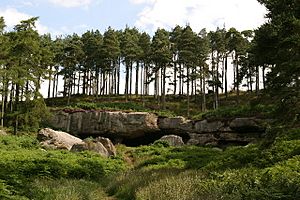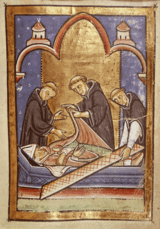St Cuthbert's Cave facts for kids
Quick facts for kids St Cuthbert's Cave |
|
|---|---|
| Native name Cuddy's Cave | |

Cuddy's Cave, Doddington Moor, near Wooler
|
|
| Location | Northumberland |
| Owner | National Trust |
| Lua error in Module:Location_map at line 420: attempt to index field 'wikibase' (a nil value). | |
St Cuthbert's Cave, also known as Cuddy's Cave, refers to two natural caves in Northumberland, England. These caves are made of sandstone. They are famous because people believe they are connected to Saint Cuthbert. He was an important Anglo-Saxon monk, bishop, and hermit who lived in the 600s.
Exploring the Doddington Cave
One of the caves is located near Doddington in Northumberland. It is a very small cave. It looks like it might have been made bigger by people long ago. At the back of the cave, there is a tiny natural tunnel.
In 1865, a man named George Tate drew some special markings found in the cave. These were Neolithic cup and ring markings. They are ancient designs carved into rocks. Sadly, you can't see these markings anymore. Tate wrote that they were very hard to see even back then. More recently, similar markings have been found nearby at Dod Law.
Discovering the Holburn Cave

The second cave is also made of sandstone. It is found in the Kyloe Hills. This area is between Belford and Lowick. The land around this cave, including the woods, is owned by the National Trust.
This cave is quite large. It has a big overhanging rock that offers shelter. It is about 24 meters wide and 3 meters high. The back wall is 7 meters from the front. There is also a natural rock pillar in the middle of the cave.
The Legend of Saint Cuthbert

Saint Cuthbert was a very important religious figure. He was known for living a simple life. He spent time as a hermit, living alone in quiet places.
According to an old book called the Anglo-Saxon Chronicle, something important happened in 875. The Danes were attacking Lindisfarne. This was a holy island where Cuthbert had lived. To protect his holy body, the monks took it and traveled for seven years.
People believe that these caves might have been places where the monks hid with Saint Cuthbert's body. Or, they might have been places where Cuthbert himself lived as a hermit before he moved to the Farne Islands. These stories make the caves special historical sites.


